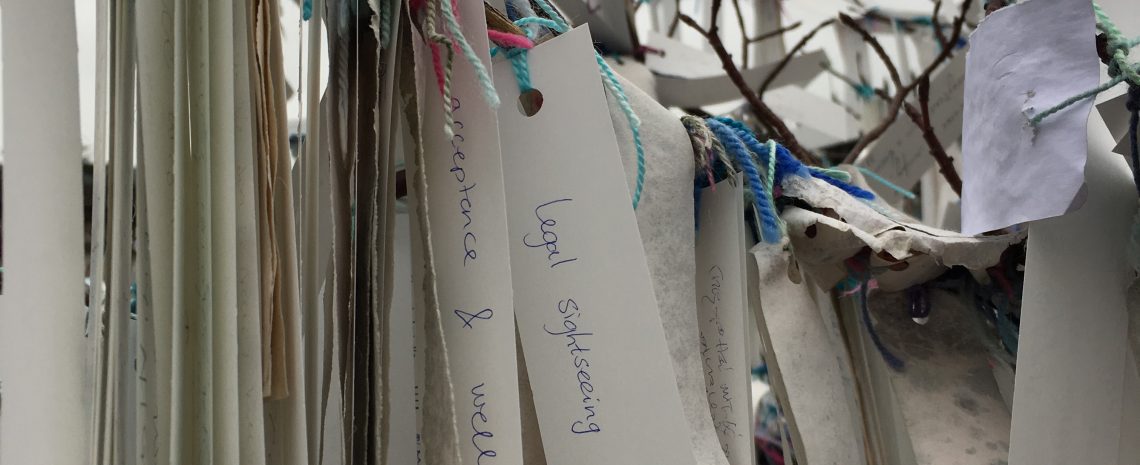by Jessie Hohmann
Botanic gardens do not immediately appear as architecture. They are more commonly seen as landscape, or at most, landscape architecture. This image, however, gestures to botanic gardens as international law’s institutional architecture. Botanic gardens form part of international law’s material structure, underpinning and sustaining its spread across the globe, and its continuing material and ideological projects. Botanic gardens serve as places where international legal aims and institutions are made to flourish and where they grow.
Botanic gardens serve as places where international legal aims and institutions are made to flourish and where they grow.
In these gardens, the stuff of international law was forged, and the objects and subjects of its regimes were created, dispersed, and made ready for protection and commercial and scientific exploitation. These included trade regimes, as discussed with respect to sugar by Fakhri and regimes for the control of plant movement to control plant pathogens, as discussed by Keogh. Botanic gardens provided a network of locations where plants taken from one part of the world could be nurtured and acclimatised before being moved on to new locations. In these new places, they could be ‘known’ as objects of science, exploited for commercial gain, and grown to sustain settler populations and colonial labour.
The image I choose here gestures to all of these intertwined international legal projects. It is an image of the fernery in the Royal Botanic Garden, Sydney. Modern red steel supports lift a shady vault for the ancient rainforest plants below. The modern structure sits within the sandstone walls of the colonial Governor’s kitchen garden. The Sydney Botanic Garden’s position on the shores of Farm Cove recalls its settler history as the first colonial farm, established in 1788. Here, colonial authorities planted wheat, barley and other European grains. They were blind to the sophisticated land management that sustained the Indigenous owners of the land, and used international law to support their claim to Australia as terra nullius. Although the first colonial farm failed, European grains – specifically wheat – dominate Australia’s export market, and the Sydney botanic garden has since been commemorated as the ‘birthplace of Australia’s primary industry’. Subsequently, the farm became the Botanic Garden, Australia’s first scientific institution, a key staging point in the introduction, and in the export, of plants across British and other empires.
We can picture the Sydney Botanic Garden as one of the supports of an international trade in plants, in people, and in commodities that spanned the globe and made European domination possible, in the way that the red steel supports and the sandstone walls hold up the mesh shading the Fernery. International law played a role not only in establishing and justifying colonies, but in providing the legal framework for exploiting them that made them lucrative endeavours for a range of public and private interests. For example, Joseph Banks botanist, land owner, and President of the Royal Society, who famously accompanied Captain Cook to Australia and returned with 30,300 plant specimens previously ‘unknown to science’, had important political and commercial interests in Empire as a site of agricultural improvement, military power, and self-sufficiency for the mother country. A network of colonial botanic gardens supported these aims ideologically, intellectually, and materially. As ideological and intellectual projects they sought to balance national interest and imperial prestige with the ‘higher’ pursuits of scientific knowledge for the benefit of ‘mankind’. Yet the early botanic garden also met basic nutritional needs, feeding the population. Commentators at the time criticised colonial officials, who provisioned their tables from the Sydney Botanic Garden’s produce at the expense of its scientific role, and it was also used to feed arriving convicts and settlers, for example while their ships lay under quarantine in harbour. The gardens thus were instrumental to the material survival of the European labour which would propel the colony into productivity, not unlike the (in)famous attempt – also championed by Banks – to introduce Tahitian breadfruit to the West Indies to feed enslaved labourers producing cash crops for the benefit of Empire. The multiple roles of colonial botanic gardens, including in Sydney, as practical, economic and scientific were inextricable from each other.
But is this just a story of the past? Botanic gardens remain central to an international conservation and research agenda that seeks to respond to climate change, biodiversity loss and other environmental challenges. Australia’s botanic gardens operate within a framework governed by the Convention on Biological Diversity and international environmental law more broadly. Australia’s gardens remain nested within ongoing international networks that overlay and often replicate Colonial patterns of centre-periphery trajectories in knowledge collection and exploitation, and remain limited in their conception of nature and its value. Investigating botanic gardens as international law’s architecture opens up questions about the past, present and future of international law. These include what sort of nature or materials of nature international law will be willing to protect or conceive of as protectable, what the legacies of colonialism and capitalist extraction are in botanic gardens, and how botanic gardens can move beyond a western frame of science and knowledge production into the future.
Jessie Hohmann is associate professor of law at the University of Technology Sydney (UTS). She is an internationally recognised expert on the right to housing. Her further research expertise includes material culture, objects and materiality of international law, and Indigenous Peoples and international law.
This piece is part of the legal sightseeing
mini-blog series on institutional architecture:
view the whole series!

